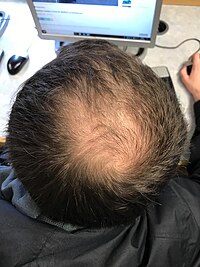
Photo from wikipedia
Dear Editor, A 36-year-old male with clinical and genetic diagnose of hereditary leiomyomatosis and renal cell cancer syndrome (HLRCC) also known as Reed syndrome (p.Arg233Cys pathogenic variant in FH gen,… Click to show full abstract
Dear Editor, A 36-year-old male with clinical and genetic diagnose of hereditary leiomyomatosis and renal cell cancer syndrome (HLRCC) also known as Reed syndrome (p.Arg233Cys pathogenic variant in FH gen, associated with HLRCC), consulted for a 6 years' history of multiple painful lesions in his back. In physical examination multiple skin-color papules arranged in plaques in scapular area and lumbar region were observed (Figure 1B–D). Screening for associated neoplasm showed no malignancy, including an abdominal MRI for RCC screening with subsequently annual MRI. Skin biopsy was performed showing a non-encapsulated tumor composed of bundles of smooth muscle arranged in an interlacing pattern, compatible with cutaneous leiomyoma (Figure 1A). Treatment with oral analgesics was not effective. Due to persistence of intense pain, we performed an intralesional botulinum toxin A (BTA) injection, 2 IU per lesion (12 lesions were treated from 0.4 to 1.2 cm) after reconstitution of 100 BTA IU vial in 5 ml of saline serum 0.9% (20 IU/ml). We performed an intradermal injection with a 30G needle. The technique was well tolerated, with only mild pain reported, and immediate pain relief was achieved, with very little episodes in the following 2 months, with progressive loss of efficacy. Treatment has been repeated every 3 months for 1.5 years maintaining an excellent response. Leiomyomas are the most common smooth muscle tumors. Cutaneous leiomyomas (CLM) are divided into three categories: piloleiomyomas (arising from the arrector pili muscle), genital leiomyomas, and angioleiomyomas. CLM may occur sporadically or in association with renal cell cancer in an autosomal dominant with incomplete penetrance disorder called HLRCC. It is characterized by multiple CLM, uterine leiomyomas and increase risk of renal cell
Journal Title: Dermatologic Therapy
Year Published: 2021
Link to full text (if available)
Share on Social Media: Sign Up to like & get
recommendations!